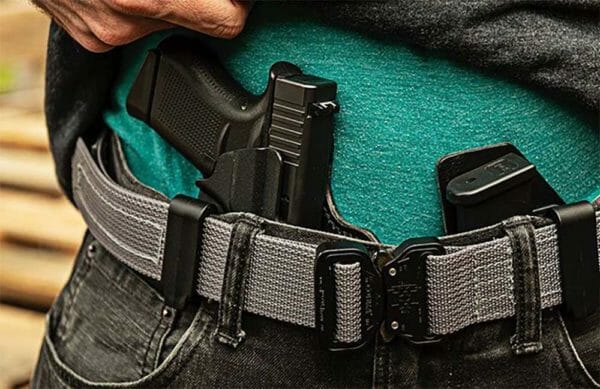Opinion

The U.S. Court of Appeals for the Second Circuit came down with its decision in Antonyuk vs. Chiumento, on December 8, 2023. The case is mostly bad news for present or prospective concealed handgun carry licensees in New York, although it’s not surprising news to us.
There is much to glean from the decision.
The Second Circuit’s rulings in Antonyuk cohere essentially with that Court’s own prior rulings, giving only lip service to the U.S. Supreme Court.
In Heller and Bruen the U.S. Supreme Court explained the faultiness of the Second Circuit’s approach to the Second Amendment and that of several of its sister Federal Appellate Courts that also abhor the natural law right codified succinctly and in the Second Amendment of the Bill of Rights. The Second Circuit apparently felt it could defy Heller because the Heller rulings, while directly affecting New York’s Handgun Law, didn’t directly refer to that Law. The Bruen rulings, though, did. The impetus for the Heller rulings, apart from the major reaffirmation of the right to keep and bear arms as an individual right, was directed to the D.C. Law on handguns.
However, since Bruen specifically dealt with New York’s Handgun Law, the Second Circuit found itself in a quandary—the nature of that quandary we had previously discussed.
See the Arbalest Quarrel article, posted on January 20, 2023, in Ammoland Shooting Sports News. What Supreme Court’s Order To NY Sate In Antonyuk vs Nigrelli Really Means.
The Second Circuit has now played its hand. Acceding to the wishes of the New York Hochul Government, it has spurned the rulings and reasoning of, and mocked and provoked, its parent, the U.S. Supreme Court.
It has echoed and amplified the sentiments of Kathy Hochul and of other New York Government officials and leaders and has made clear its own contempt for those citizens who wish to exercise their right to armed self-defense in New York.
The decision of the three Federal Appellate Judges was unanimous.
A cursory inspection of the decision may convey the impression to some that the U.S Court of Appeals for the Second Circuit found a way out of the morass:
Reassuring Governor Hochul and the Democrat Party-controlled Legislature in Albany that the New York Government can continue to enforce the CCIA and placating the Plaintiffs, New York concealed handgun carry license holders and the Second Amendment Foundation.
But, as for the latter, only a fool would think the Second Circuit gave Party Plaintiffs anything to be happy about.
True, the Appellate Court prohibited Government licensing authorities from demanding that applicants reveal their personal identifiers for social media accounts.
And the Court prohibited Government licensing authorities from mucking about in a person’s private social media accounts.
But the constraints are lessened if not negated by the Court’s copious rulings on Good Moral Character, whose use by the New York Government—the Court made clear—is Constitutional, and the enforcement of it will, then, remain a serious concern for any applicant of a New York concealed handgun carry license.
Good Moral Character is one of the two foundational components of the CCIA that infringes the core of the Second Amendment right.
Since the Court held that assessment of one’s “Moral Character” is a legitimate prerogative of Government and, since perusal of social media is a key component in the review of a person’s moral character, the Court had no wish to prevent licensing authorities from accessing social media information that would assist them in a determination of one’s character to possess a handgun in the public sphere.
So, the Court reinforced the licensing authority’s discretion to peruse an applicant’s social media with a workaround:
The Court said,
“More generally, we have already explained that it is constitutional for a state to make licensing decisions regarding an applicant’s ‘good moral character,’ at least where that ‘character’ is defined in terms of dangerousness. It must, therefore, be constitutional for the licensing authority to investigate the applicant’s character, and no one argues that a licensing officer may not inquire into the applicant’s trustworthiness beyond the challenged disclosures. It follows that the State can also require modest disclosures of information relevant to that investigation, making the (permissible) assessment of dangerousness more efficient and more accurate.”
The CCIA falls apart in the absence of “Good Moral Character” and New York’s “Sensitive Location Restrictions.”
These two things are the guts of Hochul’s CCIA.
The Government insists on their retention and is adamant that the Government can enforce them. The Second Circuit has obliged the New York Government.
Re: Good Moral Character
The Court remarked,
“We recognize that ‘good moral character’ is a spongy concept susceptible to abuse. . . .”
The concept is more than “spongy.” The Second Circuit uses that word as a makeweight to avoid acknowledging the concept is facially unconstitutional.
The Court slithers around that fact, doing what it can to deal with pragmatic concerns attendant to the concept’s application only.
But logically, the Court’s approach is flawed.
The nature of one’s character is irrelevant to one’s exercise of the natural law right to self-defense. Its application is constitutionally suspect at the get-go.
No other fundamental right necessitates a showing “Good Moral Character” as a condition precedent to a citizen’s exercising his natural law right.
The Court should have investigated whether and not have assumed that Good Moral Character is an appropriate, legitimate, legal, logical, ethical, and pragmatic concept to be employed in a matter involving exercising a fundamental, natural law right.
It dispensed with all of this except for the ostensible pragmatic reason for keeping it.
The Court said this:
“The CCIA’s definition of ‘character’ is a proxy for dangerousness: whether the applicant, if licensed to carry a firearm, is likely to pose a danger to himself, others, or public safety. And there is widespread consensus (notwithstanding some disputes at the margins) that restrictions which prevent dangerous individuals from wielding lethal weapons are part of the nation’s tradition of firearm regulation. We therefore cannot conclude that every denial on grounds of ‘good moral character’ as defined by New York will violate the Second Amendment, though various avenues lie open for as-applied challenges.”
From a close reading of the text of the opinion, one can infer the Second Circuit concedes, albeit only tacitly, the dubious legality of employing “Character” to deny one the exercise of a fundamental, unalienable, natural law right.
More to the point, if “Dangerousness” is really of concern, then why do two standards for Good Moral Character exist in the New York Handgun Law—
One for those few individuals who make application only for a restricted “premise” license that does not permit the licensee to use a handgun lawfully for self-defense while in the public domain, and another, a new, more robust, standard for those individuals—most individuals—who apply for a concealed handgun carry license that ostensibly allows for the lawful use of a handgun for self-defense in the public domain?
Re: “Sensitive Location” Restrictions
The concepts of “Sensitive Location” Restrictions and the bolstered “Good Moral Character” Requirement are as ingenious as they are devious.
The two operate in tandem as a substitute for “Proper Cause” (i.e., “Extraordinary Need”), which the U.S. Supreme Court ruled unconstitutional.
The Hochul Government concocted a “Sensitive Location Restrictions” mechanism to transform the “Unrestricted” Concealed Carry License into—what is now effectively—a “Highly Restricted” Concealed Carry License, and for all such license holders.
Why did the Hochul Government do this? It did this because The U.S. Supreme Court has compelled the Hochul Government to grant more concealed handgun carry licenses to many more applicants, and the Government is decidedly unhappy about this—enraged, in fact.
The Government has, therefore, imposed a bizarre, extensive, ad hoc patchwork quilt of areas in the public sphere where civilians who hold valid licenses are prohibited from lawfully carrying a handgun for self-defense, thereby transforming all unrestricted carry into restricted carry.
N.Y. Penal L. § 265.01-e is the “Sensitive Location” statute.
There are many areas where a concealed carry license holder is prohibited from carrying and using a handgun for self-defense, as stated in this statute.
The lower District Court imposed a preliminary injunction on most of these areas, and apart from one instance involving one Church, the Second Circuit broadly vacated the District Court’s granting of the Plaintiffs’ preliminary injunction.
This means the Hochul Government may continue to enforce restrictions on concealed carry in those areas. The Second Circuit has set its imprimatur on this.
There is no point in Plaintiffs spending time and money to request an en banc hearing of the full complement of Second Circuit Judges to rehear the case, which the Court can peremptorily deny anyway. And the U.S. Supreme Court is likely to take the case up for review since the CCIA is a direct, unabashed assault on and affront to the Bruen rulings.
And, just as likely, the High Court will not have kind words for the Second Circuit, whose reasoning and rulings in Antonyuk are blatantly inconsistent with the High Court’s own reasoning and rulings in Bruen and Heller.
Antonyuk vs. Chiumento U.S. Court of Appeals for the Second Circuit Opinion
About The Arbalest Quarrel:
Arbalest Group created `The Arbalest Quarrel’ website for a special purpose. That purpose is to educate the American public about recent Federal and State firearms control legislation. No other website, to our knowledge, provides as deep an analysis or as thorough an analysis. Arbalest Group offers this information free.
For more information, visit: www.arbalestquarrel.com.

from https://ift.tt/qzHmaS5
via IFTTT

No comments:
Post a Comment